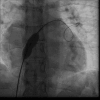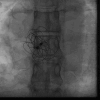Atrial Septal Defect (ASD) Repair Unveiling an Unusual Conduction Conundrum: A Wenckebach Case Report
- PMID: 38993432
- PMCID: PMC11238892
- DOI: 10.7759/cureus.62073
Atrial Septal Defect (ASD) Repair Unveiling an Unusual Conduction Conundrum: A Wenckebach Case Report
Abstract
Atrial septal defects are a common congenital malformation that can lead to an elevated risk for stroke due to the bypass of the lungs by deep vein thrombosis, as well as the expected repercussions of pulmonary hypertension if left untreated. Surgical intervention is definitive; however, recent advancements in treatment options, such as percutaneous intervention, represent a safer and equally effective way to treat this congenital complication. While safer, percutaneous interventions can also lead to adverse events that may force patients to present to the emergency department. Here, we present a unique case of a patient with congenital atrial septal defect status post-percutaneous intervention who developed a new-onset second-degree AV block, Mobitz type 1 Wenckebach rhythm.
Keywords: arrhythmia; atrial septal defect (asd); av block; cardiology; congenital heart disease; eisenmenger syndrome; mobitz type 1 wenckebach; percutaneous intervention; pulmonary hypertension; stroke risk.
Copyright © 2024, Van Ligten et al.
Conflict of interest statement
Human subjects: Consent was obtained or waived by all participants in this study. Mayo Clinic Institutional Review Board issued approval 24-004683. Mayo Clinic Institutional Review Board deems this study exempt and approves of research. . Conflicts of interest: In compliance with the ICMJE uniform disclosure form, all authors declare the following: Payment/services info: All authors have declared that no financial support was received from any organization for the submitted work. Financial relationships: All authors have declared that they have no financial relationships at present or within the previous three years with any organizations that might have an interest in the submitted work. Other relationships: All authors have declared that there are no other relationships or activities that could appear to have influenced the submitted work.
Figures





Similar articles
-
Arrhythmias and conduction disorders associated with atrial septal defects.J Thorac Dis. 2018 Sep;10(Suppl 24):S2940-S2944. doi: 10.21037/jtd.2018.08.27. J Thorac Dis. 2018. PMID: 30305954 Free PMC article. Review.
-
Distal His bundle pacing in a patient with surgically corrected complex Ebstein anomaly and symptomatic second-degree atrioventricular block: a case report.Eur Heart J Case Rep. 2023 Oct 31;7(12):ytad531. doi: 10.1093/ehjcr/ytad531. eCollection 2023 Dec. Eur Heart J Case Rep. 2023. PMID: 38046645 Free PMC article.
-
Case report: The impact of percutaneous atrial septal defect closure in pulmonary hypertension with co-existing cor triatriatum sinister and multiple cardiac comorbidities.Front Cardiovasc Med. 2022 Sep 7;9:913391. doi: 10.3389/fcvm.2022.913391. eCollection 2022. Front Cardiovasc Med. 2022. PMID: 36158850 Free PMC article.
-
Ivabradine for inappropriate sinus tachycardia-induced symptomatic Mobitz type I atrio-ventricular block: a case summary.Eur Heart J Case Rep. 2023 Jun 9;7(6):ytad192. doi: 10.1093/ehjcr/ytad192. eCollection 2023 Jun. Eur Heart J Case Rep. 2023. PMID: 37360007 Free PMC article.
-
Interventional Therapy Versus Medical Therapy for Secundum Atrial Septal Defect: A Systematic Review (Part 2) for the 2018 AHA/ACC Guideline for the Management of Adults With Congenital Heart Disease: A Report of the American College of Cardiology/American Heart Association Task Force on Clinical Practice Guidelines.Circulation. 2019 Apr 2;139(14):e814-e830. doi: 10.1161/CIR.0000000000000605. Circulation. 2019. PMID: 30586769
References
-
- Comparison of medical treatment with percutaneous closure of patent foramen ovale in patients with cryptogenic stroke. Windecker S, Wahl A, Nedeltchev K, et al. J Am Coll Cardiol. 2004;44:750–758. - PubMed
-
- A comparison of surgical and medical therapy for atrial septal defect in adults. Konstantinides S, Geibel A, Olschewski M, et al. N Engl J Med. 1995;333:469–473. - PubMed
-
- Transcatheter closure of secundum atrial septal defects in adults with the Amplatzer septal occluder: intermediate and long-term results. Spies C, Timmermanns I, Schräder R. Clin Res Cardiol. 2007;96:340–346. - PubMed
-
- Percutaneous device closure of secundum atrial septal defect in older adults. Dehghani H, Boyle AJ. https://www.ncbi.nlm.nih.gov/pmc/articles/PMC3371622/ Am J Cardiovasc Dis. 2012;2:133–142. - PMC - PubMed
-
- Menillo AM, Lee LS, Pearson-Shaver AL. StatPearls [Internet] Treasure Island (FL): StatPearls Publishing; 2024. Atrial Septal Defect. - PubMed
Publication types
LinkOut - more resources
Full Text Sources
